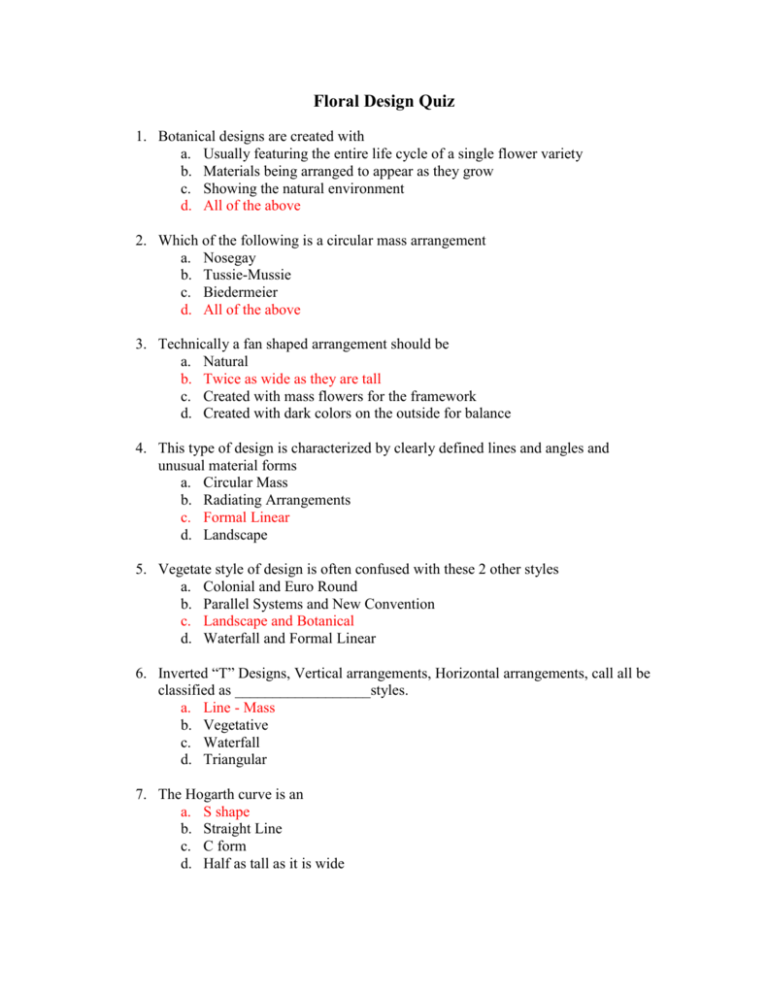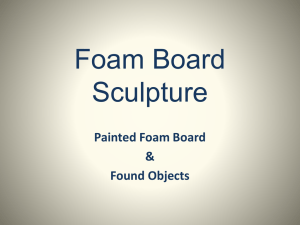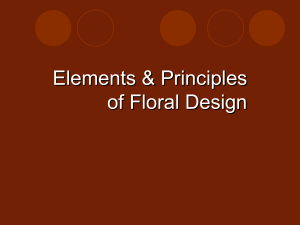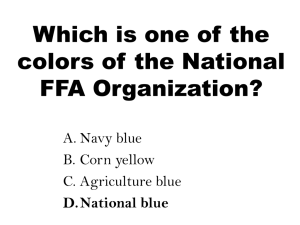Floral Design Quiz
advertisement

Floral Design Quiz 1. Botanical designs are created with a. Usually featuring the entire life cycle of a single flower variety b. Materials being arranged to appear as they grow c. Showing the natural environment d. All of the above 2. Which of the following is a circular mass arrangement a. Nosegay b. Tussie-Mussie c. Biedermeier d. All of the above 3. Technically a fan shaped arrangement should be a. Natural b. Twice as wide as they are tall c. Created with mass flowers for the framework d. Created with dark colors on the outside for balance 4. This type of design is characterized by clearly defined lines and angles and unusual material forms a. Circular Mass b. Radiating Arrangements c. Formal Linear d. Landscape 5. Vegetate style of design is often confused with these 2 other styles a. Colonial and Euro Round b. Parallel Systems and New Convention c. Landscape and Botanical d. Waterfall and Formal Linear 6. Inverted “T” Designs, Vertical arrangements, Horizontal arrangements, call all be classified as __________________styles. a. Line - Mass b. Vegetative c. Waterfall d. Triangular 7. The Hogarth curve is an a. S shape b. Straight Line c. C form d. Half as tall as it is wide 8. Parallel placements and negative space groups are defining characteristics of a. New convention b. Oval Designs c. Pointed oval design d. L shaped designs 9. Which of the these is an example of a Symmetrical triangle a. Equilateral b. Vertical Isosceles c. Horizontal Isosceles d. All of the above 10. Waterfall designs are characterized by a. A downward flow of materials b. Heavy use of foliage c. A layered look of materials d. All of the above 11. Physical balance is achieved when a. An arrangement will stand stably on its own and will not topple b. It appears to be unbalanced or unstable c. Is equal on both sides d. Identical flowers are used 12. Which of the following is NOT a form of Visual Balance? a. Symmetrical b. Asymmetrical c. Open balance d. Closed 13. This principle attracts the eyes of the viewer and creates a focal point a. Balance b. Emphasis c. Harmony d. Proportion 14. In using a rose in a wire and taped corsage what type of wiring would you use a. Pierce method b. Hook method c. Wraparound method d. All the above 15. When all the components of an arrangement blend well together, this principle is achieved a. Balance b. Emphasis c. Harmony d. Waterfall 16. Often the most important element contributing to harmony is a. Color b. Form c. Line d. Space 17. The comparative size relationship between various parts of an arrangement refers to the a. Balance b. Emphasis c. Harmony d. Proportion 18. A Triadic color combination is a. Orange, and blue b. Red, and green c. Red, yellow, and blue d. All the above 19. Recommended height proportion of flowers to container is a. 1 times b. 1.5 to 2 times c. 3 times d. The same size 20. Scale refers to a. The size of the flowers to the container b. The size of the relationship between the materials in the design c. The golden ratio used in the design d. The size relationship between the design and its setting 21. The visual flow or movement within an arrangement is a. Proportion b. Harmony c. Rhythm d. Rhyme 22. Which of the following is NOT a method of creating rhythm? a. Repetition b. Proximity c. Transition d. Radiation 23. This principle refers to the relationship of the individual materials or elements to each other a. Harmony b. Repetition c. Emphasis d. Unity 24. Which of the following is not needed for good floral design? a. Rhythm b. Harmony c. Balance d. All are Necessary 25. Red, Yellow and Blue are a. Primary colors b. Secondary colors c. Tertiary colors d. Neutral colors 26. The colors orange and blue form a __________ color Scheme a. Monochromatic b. Analogous c. Triadic d. Complementary 27. Which of the following color groups create an analogous color scheme? a. Red, red-orange, and red-violet b. Violet and yellow c. Red violet, violet, and orange d. Red, yellow, and blue 28. A hue is known as a. The name of a pure color b. A color with white added c. A color with gray added d. Term used for a collection of color that look good together 29. A tone is know as: a. The name of a full intensity color b. A color with white added c. A color with gray added d. Term used for a collection of color that look good together 30. Warm colors include a. Red, blue, yellow b. Green, purple, blue c. Red, Orange, Yellow d. All of the above 31. This element refers to the outline or the 3 dimensional shape of the arrangement a. Line b. Color c. Form d. Texture 32. Roses, Carnations, asters and hydrangeas are examples of a. Line materials b. Form materials c. Filler materials d. Mass materials 33. Irises, orchids, birds-of-paradise and Monstera foliage are examples of a. Line materials b. Form materials c. Filler materials d. Mass materials 34. This element provides a visual pathway for a viewer’s eyes to follow when looking at an arrangement a. Line b. Color c. Form d. Space 35. The empty or open area between materials is called a. Empty space b. Color c. Form d. Space 36. The surface quality or characteristics of a material is called a. Color b. Form c. Texture d. Space 37. When soaking floral foam which of the following should you do? a. Force the floral foam under the water b. Turn the foam under running water to get wet c. Allow for the foam to float freely d. All of the above 38. To secure the foam in the container which of the following cam be used a. Waterproof tape b. Hot-melt glue c. Anchor pins d. All of the above 39. Preparing a container with foliage prior to arranging the flowers is commonly known as a. Gridding b. Greening c. Foliage rule d. Foliating 40. Applying foliage around the edge of the container only when greening is called a. Mossing b. Collaring c. Wrapping d. Lacing 41. A creating a network of interwoven stems that support and hold each other in positions when greening a vase arrangement is a a. Mossing b. Collaring c. Wrapping d. Lacing 42. Mechanics for adding candles include which of the following a. Candle stake b. Wood picks c. Anchor pins d. All of the above 43. Which form of wiring should be used for a daisy like flower a. Pierce wiring b. Hook wiring c. Insertion wiring d. Hairpin wiring 44. Which form of wiring should be used with leather leaf fern a. Pierce wiring b. Hook wiring c. Wraparound wiring d. Hairpin wiring 45. Floral tape is used to a. Tape floral foam to the container b. Create a grid on a vase c. Wrap the floral wires added to flowers or foliages d. All of the above 46. For making a corsage with fresh flowers the right choice of glue is a. Cold glue b. Hot Glue c. Elmer’s Glue d. None of the above 47. Leaf shine should not be used on foliages prior to gluing because a. The leaf loses water b. It prevents glue from adhering c. Breaks down the plant structure d. It shortens the life of the foliage and flowers 48. All forms of gluing require a grid which is a(n) a. Basic skeleton to which flowers can be adhered b. Outline of the design c. Process done to preserve flowers d. All of the above 49. Corsages grids can be made out of a. Permanent botanical leaves b. Green chenille stems c. Any structure that will hold glue d. All of the above 50. Which of the following is NOT true about gluing basics a. Pour about ½ teaspoon onto a disposable surface b. Dip ends of stem making sure to cover the ends with glue c. Start with larger, heavier flowers d. Bag and place immediately into a cooler 51. Which of the following is a way to overcome floral adhesive challenges a. Keep a pair of pliers handy to help lift a sticky lid b. Use a corsage pin for a cap for the tube glue c. Always store glue upright to prevent leakage d. All of the above









